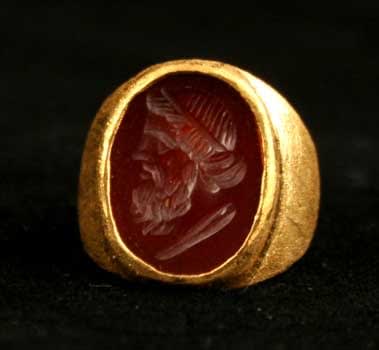Gold Ring Featuring a Roman Carnelian Seal Depicting the Bust of a Severan Emperor, 3rd Century CE
Gold and Carnelian
FJ.7244
This genuine Ancient Roman carnelian seal has been mounted in a modern 22 Karat gold ring with a Florentine finish. The art of glyptics, or carving on colored precious stones,...
This genuine Ancient Roman carnelian seal has been mounted in a modern 22 Karat gold ring with a Florentine finish.
The art of glyptics, or carving on colored precious stones, is probably one of the oldest known to humanity. Intaglios, gems with an incised design, were made as early as the fourth and third millennia B.C. in Mesopotamia and the Aegean Islands. The exhibit a virtuosity of execution that suggests an old and stable tradition rooted in the earliest centuries. The tools required for carving gems were simple: a wheel with a belt-drive and a set of drills. Abrasives were necessary since the minerals used were too hard for a metal edge. A special difficulty of engraving intaglios, aside from their miniature size, was that the master had to work with a mirror-image in mind.
The art of glyptics, or carving on colored precious stones, is probably one of the oldest known to humanity. Intaglios, gems with an incised design, were made as early as the fourth and third millennia B.C. in Mesopotamia and the Aegean Islands. The exhibit a virtuosity of execution that suggests an old and stable tradition rooted in the earliest centuries. The tools required for carving gems were simple: a wheel with a belt-drive and a set of drills. Abrasives were necessary since the minerals used were too hard for a metal edge. A special difficulty of engraving intaglios, aside from their miniature size, was that the master had to work with a mirror-image in mind.
